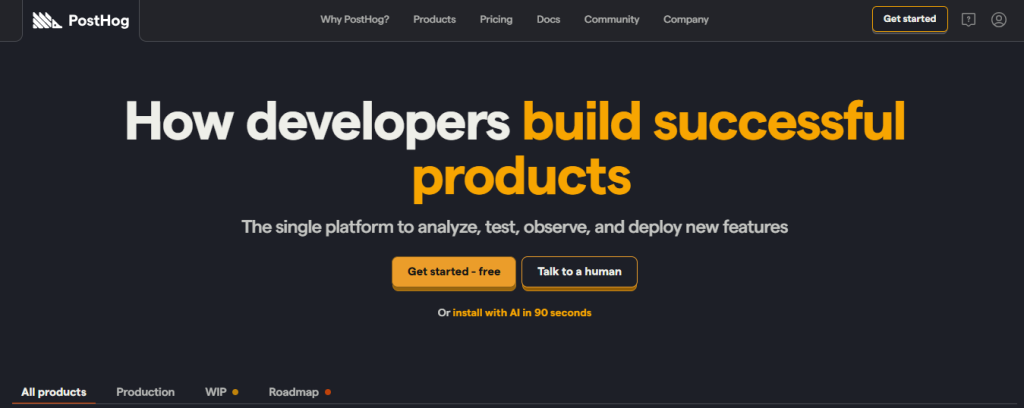PostHog Raises $70M to Let Developers Build Better Products, Faster
July 12, 2025
byFenoms Startup Research

PostHog, the open-source product analytics platform built specifically for engineers, has just raised a $70 million Series D round to supercharge its developer-first approach to product analytics. Co-founded by James Hawkins and Tim Glaser, PostHog is doubling down on building a single, all-in-one stack that helps developers analyze, test, observe, and ship new features - all without needing to send data to third parties.
The round was backed by a formidable lineup of investors including Stripe, GV (Google Ventures), Y Combinator, and Formus Capital, marking one of the largest late-stage funding rounds in the developer tools category this year.
This new capital will help PostHog continue expanding its self-hosted offering, build deeper AI-native tooling, and scale go-to-market operations as demand for product-led growth infrastructure continues to skyrocket.
What Problem Does PostHog Solve?
Most analytics tools were designed with marketers and PMs in mind. That’s a problem when developers are increasingly owning the product experience from end to end.
PostHog flips the script by focusing on developer autonomy. Rather than fragmenting the analytics stack across vendors for heatmaps, funnels, A/B testing, feature flags, and session replay - PostHog offers a unified platform that runs in your own infrastructure or cloud environment.
Key features include:
- Self-hosted deployment with full data ownership
- Event-based analytics with real-time insights
- Integrated feature flags and A/B testing
- Session recording and heatmaps
- Product observability tools
- AI copilots for funnel insights and user journey debugging
This allows teams to go from “What’s happening?” to “Let’s fix it” without jumping between tools or breaking compliance.
Why It Matters Now
The developer toolchain is consolidating. With the rise of product-led growth, developers are no longer just building - they’re owning outcomes. That means having tools that move as fast as they do, without handing data over to third-party vendors or waiting on analysts for answers.
A 2023 Segment report found that 54% of product teams still rely on 3+ tools just to get a complete picture of user behavior. Meanwhile, data privacy regulations (GDPR, CCPA, etc.) are putting pressure on companies to own their data and minimize unnecessary integrations.
PostHog sits at the intersection of three major trends:
- The rise of product-led growth, where engineers drive the user experience
- The decline of data trust in SaaS tools, especially among privacy-conscious teams
- The shift toward open-source, self-serve platforms that empower developers
And here’s the real unlock for founders building in deep stacks: PostHog didn’t win by launching with a flashy interface or a viral launch post. They won because they understood who suffers when tooling gets fragmented. It’s the developer chasing bugs across five platforms. It’s the growth engineer waiting 24 hours for funnel data. So instead of chasing features, PostHog built toward a workflow truth - that velocity doesn’t come from speed alone, but from owning every feedback loop that drives product iteration.
If you’re building infrastructure for builders, the question isn’t just “how can I make this faster?” It’s: “how do I eliminate delay between insight, action, and iteration?” Products that control that loop don’t just become sticky - they become critical path infrastructure.
Market Outlook: The Product Analytics Stack Is Being Rebuilt from the Developer Up
PostHog’s growth isn’t just a reflection of technical execution - it’s a signal that product analytics is undergoing a structural shift.
The global product analytics market is projected to reach $29.2 billion by 2030, growing at a CAGR of 20.3%, driven by the rise of SaaS, mobile-first experiences, and data-driven growth loops.
- 61% of product teams report dissatisfaction with current analytics workflows due to complexity and latency.
- Developer-first companies like Vercel, Retool, and Supabase are leading a broader movement toward tools that are programmable, self-hostable, and privacy-conscious.
- Open-source software now accounts for over 80% of modern application stacks, up from 36% in 2011.
- A McKinsey study shows companies that tightly align product and engineering with embedded analytics see 2.6x faster iteration cycles.
As the line blurs between analytics, experimentation, and deployment, PostHog is positioning itself as the control center for modern dev teams - not just a dashboard, but a platform for shipping faster, smarter, and with confidence.
What’s Next for PostHog?
With this $70M infusion, PostHog plans to:
- Grow its open-source community and expand the core platform capabilities
- Invest in AI features that surface funnel drops, user churn signals, and behavioral patterns automatically
- Scale their self-serve go-to-market engine, targeting startups, scaleups, and enterprise teams migrating off legacy analytics stacks
- Support edge deployment models for low-latency observability in regulated industries
PostHog’s mission remains clear: empower developers to build better products - without friction.
And in a world where every product is becoming more technical, that might just be the most powerful growth engine of all.









